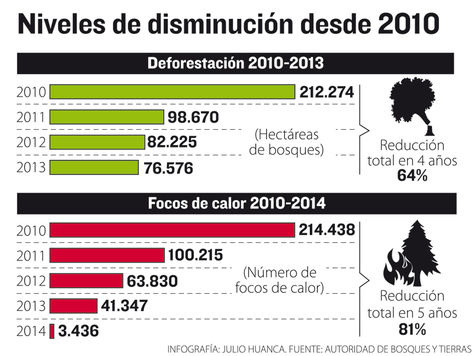To celebrate Earth Day 2017, which is tomorrow, I would like to highlight the important findings of a paper by Campbell et al. published earlier this month in Nature (1). The paper documents, through the analysis of air trapped in ice from Antarctica, that the growth of global terrestrial gross primary production (GPP) –the amount of carbon dioxide that is ‘fixed’ into organic material through photosynthesis– is larger now than it has been at any time during the last 54,000 years. This basically means that the planet is greener and nature is thriving more now than at any time during human history, despite all the havoc we humans are wreaking everywhere.
Deforestation reduced – mission accomplished or too good to be true?

By: Lykke E. Andersen*
During the last decade, Bolivia had one of the highest per capita deforestation rates in the World (1). Apart from this being decidedly unkind to Mother Earth and exacerbating problems of wild fires, droughts and flooding in Bolivia, this also caused Bolivians to be among the biggest contributors to CO2 emissions in the World (approximately 11 t/CO2/person/year – more than almost all European countries and more than twice the global average) (2).
This was obviously a major problem in Bolivia, and at INESAD we have been working for several years on promoting policies to reduce deforestation. Thus, we should be thrilled by the recent news from ABT showing that Bolivia has reduced deforestation by 64% since 2010 (see Figure 1).

Source: La Razon, 23 July 2014 (http://www.la-razon.com/sociedad/ABT-Bolivia-redujo-deforestacion-bosques-anos_0_2093790639.html#.U9I6T0RWunI.facebook).
But it almost seems too good to be true. I suspect that everybody working in this area are asking themselves: Can this really be true?
INESAD News: The Potential of Bamboo for Carbon Sequestration in Bolivia
 A newly-released INESAD Working Paper reveals how bamboo forests in Bolivia have a significant role to play in the global fight against climate change. The multi-author paper, entitled “A Measurement of the Carbon Sequestration Potential of Guadua Angustifolia in the Carrasco National Park“, is based on a study of an unmanaged and previously unstudied bamboo forest. INESAD researchers found that this forest has the ability to store around 100 tons of carbon per hectare, in the stems, branches, and leaves of the bamboo, which is more than some species of tree such as Chinese Fir.
A newly-released INESAD Working Paper reveals how bamboo forests in Bolivia have a significant role to play in the global fight against climate change. The multi-author paper, entitled “A Measurement of the Carbon Sequestration Potential of Guadua Angustifolia in the Carrasco National Park“, is based on a study of an unmanaged and previously unstudied bamboo forest. INESAD researchers found that this forest has the ability to store around 100 tons of carbon per hectare, in the stems, branches, and leaves of the bamboo, which is more than some species of tree such as Chinese Fir.
The carbon stored in a forest comes from the carbon dioxide (CO2) that it absorbs. CO2 is a harmful greenhouse gas produced by the burning of fossil fuels, which accumulates in the atmosphere and traps heat. This artificial change in the composition of the atmosphere is what causes climate change. Hence forests play a vital role in mitigating climate change, because they absorb CO2 which would otherwise end up in the atmosphere. See Exactly How Do Trees Fight Climate Change? for more details about this process. Read More »
Read More »
What Can Bamboo Do About CO2?
 Efforts to thoroughly study the role that plants play in climate change mitigation are increasing. Most researchers focus on the promise of large, leafy forest trees to help remove carbon from the atmosphere; for example Lal (1998) in India, Chen (1999) in Canada, Zhang (2003) in China, and Monson ( 2002) in the United States. This is because, generally speaking, the bigger the plant, the more CO2 it absorbs – click here to see how plants do this – and trees are the most obvious large plant species. However, there are some very large non-tree plants in the world and increasing evidence points to a surprising grassy climate change warrior: bamboo.
Efforts to thoroughly study the role that plants play in climate change mitigation are increasing. Most researchers focus on the promise of large, leafy forest trees to help remove carbon from the atmosphere; for example Lal (1998) in India, Chen (1999) in Canada, Zhang (2003) in China, and Monson ( 2002) in the United States. This is because, generally speaking, the bigger the plant, the more CO2 it absorbs – click here to see how plants do this – and trees are the most obvious large plant species. However, there are some very large non-tree plants in the world and increasing evidence points to a surprising grassy climate change warrior: bamboo.
One species of bamboo, the guadua angustifolia, found in Venezuela, Ecuador, and Colombia, has been shown to grow up to 25 meters in height and 22 centimeters in diameter, with each plant weighing up to 100 kilograms (Rojas de Sánchez, 2004). This doesn’t match the stature of many trees, but it is still big enough to be significant. It is not all about size, however. How fast a plant grows has a part in determining how much CO2 it can absorb in a given time. In this respect, bamboo wins hands-down: it grows faster than many trees, growing up to 1.2 meters per day. In fact, bamboo holds the Guinness World Record for the world’s fastest growing plant. Read More »
Exactly How Do Trees Fight Climate Change?

Much is written about the need to reduce deforestation and replant the forests that have been logged for human use and economic development. This is because trees are needed for fighting climate change and vital to the very survival of the planet. But what is it exactly that makes trees and other plants so special?
Climate change is caused, at least partly, by man-made emissions of greenhouse gases which accumulate in the Earth’s atmosphere and trap heat. The Intergovernmental Panel on Climate Change (IPCC), set up in 1988 by the United Nations Environment Programme (UNEP) and the World Meteorological Organization (WMO), and endorsed by the General Assembly of the United Nations, is the leading international body for assessing this phenomenon.
In their most recent Assessment Report from 2007, the IPCC reported that carbon dioxide (CO2) is the most significant anthropogenic greenhouse gas, both in the sense of the amount of heat it traps and the quantity that is released into the atmosphere (mainly from the burning of fossil fuels). Forests are very effective ‘carbon sinks’, extracting CO2 from the atmosphere and keeping it locked away for long periods of time. Therefore, some of the key strategies to alleviate the causes and effects of climate change recommended by the IPCC include efforts to reduce deforestation, while simultaneously increasing afforestation and reforestation: planting of forests where none were before and replanting areas where forest has been removed, respectively. Read More »
We try to protect the biosphere, but what about the Ethnosphere?
 According to the Living Planet Report issued in 2012 by the Word Wildlife Fund Global, due to increasing deforestation, natural resource procurement, and habitat destruction, global biodiversity—plethora of plant and animals found on the planet—has decreased by 30 percent since the 1970s with tropical zones incurring a 61 percent loss. This fact is shocking but will not come as a surprise to many. What few people realize, however, is that the world is seeing an equally staggering loss of cultures, traditions, and ways of life due to the same manmade conditions, a loss that significantly decreases the chances of a sustainable future.
According to the Living Planet Report issued in 2012 by the Word Wildlife Fund Global, due to increasing deforestation, natural resource procurement, and habitat destruction, global biodiversity—plethora of plant and animals found on the planet—has decreased by 30 percent since the 1970s with tropical zones incurring a 61 percent loss. This fact is shocking but will not come as a surprise to many. What few people realize, however, is that the world is seeing an equally staggering loss of cultures, traditions, and ways of life due to the same manmade conditions, a loss that significantly decreases the chances of a sustainable future.
One way we can measure cultural destruction is to examine the loss of language. A product of a culture that evolved over many generations, language embodies a culture’s imagination and unique perspective of viewing the world into a concise, single form of expression. This means every time a language dies so does a unique conglomerate of knowledge that took hundreds of generations to develop. Read More »
Graphics: Exactly why should we protect ecosystems?
 To coincide with INESAD’s November Environmental Sustainability month, today’s Monday Graphics series is making a case for the worth of stable ecosystems.
To coincide with INESAD’s November Environmental Sustainability month, today’s Monday Graphics series is making a case for the worth of stable ecosystems.
Assessing Forest Growth and Air Quality.
The first infographic based on a UN Seminar on Energy for Sustainable Development conducted in 2011, despite the increase in Europe’s paper production over the past 20 years, forest growth has exceeded the harvest of forest goods by 45 percent. This translates to an increase in air quality as un-harvested forests provide valuable ecosystem services such as carbon capture. Read More »
Five Types of Rainforest Ecosystem Services that Nourish People and Planet
 According to Conservation International‘s 2009 book, The Wealth of Nature, ecosystems support and regulate all natural processes on earth, while contributing to cultural, social, and economic benefits to human communities. These have become known as ecosystem services and, according to the Rainforest Conservation Fund (RCF), they would cost trillions of dollars per year if human beings had to provide them for themselves. Here are just five types of many of the ecosystem services provided to people and planet by the world’s rainforests: Read More »
According to Conservation International‘s 2009 book, The Wealth of Nature, ecosystems support and regulate all natural processes on earth, while contributing to cultural, social, and economic benefits to human communities. These have become known as ecosystem services and, according to the Rainforest Conservation Fund (RCF), they would cost trillions of dollars per year if human beings had to provide them for themselves. Here are just five types of many of the ecosystem services provided to people and planet by the world’s rainforests: Read More »
Can economics protect the environment?
“When the last tree is cut down, the last fish eaten, and the last stream poisoned, you will realize that you cannot eat money,” Native American saying
“Sustainable development is development that meets the needs of the present without compromising the ability of future generations to meet their own needs,” Brundtland Report
It is undeniable that our current way of life is unsustainable; If every country consumed resources and created waste at the same per person rate as the United States, we would need three to five planets to survive. Part of the problem lies in the fact that economics—the major discipline advising global and national policy—has failed to include the environment in its calculations. To rectify this problem, different methods have been proposed, so as to make predictions and come up with better ways of managing the planet’s resources without compromising the future.
GUEST ROAST: Symbiotic demand—A new mechanism to reward sustainable farms’ ecosystem services
By Tim Gieseke
“Give me a lever long enough and a place to stand, and I will move the world.” Archimedes, 230 BC
Nothing seems to loom larger than the degradation of the environment at the hand of the growing global economy. This antagonistic relationship has been recognized for centuries and was made famous by Garrett Hardin’s 1967 essay of the “Tragedy of the Commons”. Read More »
 Development Roast Giving international development a proper roasting
Development Roast Giving international development a proper roasting

